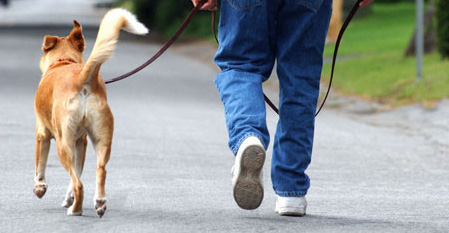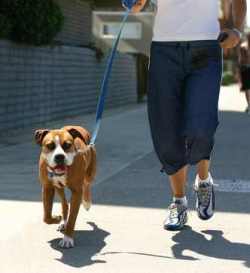
In previous articles we have gone over techniques to teach your dog how to sit and roll over which are good “tricks” that show off your pet’s intelligence and obedience. This time we are focusing on a more practical command. The “heel” command is one that is very useful in the day to day routine of having a dog. It is a very handy method to keep your pet close by your side when distractive things cross their path such as small animals, children or other dogs.
First let’s take a quick look into what the heel command actually entails. When your dog is in a successful heel position it basically means that they are close to their owner and will not run off or move unless instructed otherwise. Due to the inquisitive and exploratory nature of canines it is not the easiest command to learn, but with patience and repetition any dog can master it.
We have outlined some easy to follow steps below for you to use as a guide when teaching your dog this command. You can use these steps with a leash on or off, but it is very important not to use a leash to force your pet into position or pull them back to you. The whole goal of teaching a dog to heel is to have them want to be by your side and not force them to be there.
Teaching a Dog to Heel – Step by Step
1. First, stand up straight with your dog just beside your left leg. You and your furry friend should be facing the same direction.
2. Keep a treat in your left hand and hold it up above the dog’s head. Call your dog’s name in order to get their attention. Take a couple of steps forward and if your dog follows and remains close to your leg give them praise and the treat.
3. After you have given them a treat go ahead and repeat the process again. Take two more steps and offer them some encouragement by saying “Come on” or “Good dog.” If they follow AND stay in the heel position then offer them more praise and another treat.
4. By now, your dog should be fairly interested in this activity. Especially if he has done well and has gotten a few treats. Remember that you must use treats only as a reward for correct behavior and not to lure them to your side.
5. Continue the process of moving a few steps at a time and waiting to see if your dog follows and remains close by. If they stay back or run ahead do not praise or give them a treat. Simply say “no” and start over.
6. Eventually your dog will get pretty comfortable with just moving a couple of steps with you. At this point you can increase the number of steps. As soon as your dog seems to master heeling at a certain distance, increase that distance by twice as much.
7. Soon enough your dog will start to heel reliably for longer distances. When they get to the point where they are heeling for more than 12 feet or so you can start implementing a verbal command for them to associate with this behavior. Before you begin to move forward start saying your dog’s name to get their attention followed by a chosen command word, which is usually “heel.” They should begin to associate the activity with the command.
8. You have now laid the groundwork for teaching a dog to heel. It is necessary to slowly introduce certain conditions that might occur out in the real world to enhance their ability. Try adding these elements and see how they can handle them. If they do well remember to reward them with praise and a treat.-Change your walking speed while they are following you. Speed up, slow down, or stop at various intervals.
-Take your dog out to a more public area away from home.
-Make some left and right turns.
-Practice heeling around distractions like other people and animals.
-Try distracting the dog with toys or a tennis ball and see if they hold steady.
 | After a little patience and practice you should start to notice that your dog stays at your side when commanded and is much less distracted or prone to run off on a chase. This is a process that can take several weeks and you shouldn’t expect perfect results in a few days of training. Teaching a dog to heel is much like teaching them to follow any other command, with time and determination they will learn and remember it for the rest of their lives. |
| Russ Barker has chosen teaching a dog to heel as his next installment in his dog tricks series of blog articles because it is a very practical thing for any dog to know. Russ is a super handsome and ridiculously charming blogateer for DogTagArt.com, a collaboration of pet enthusiasts that have built a fantastic website with pet safety and style at the forefront. They provide personalized pet ID tags and let users show off their creative side. These colorful custom dog tags make a bold statement while ensuring pets are fully protected if they decide to wander off. |  |

